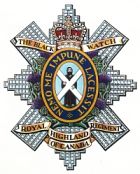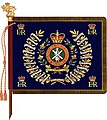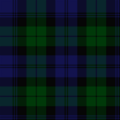|
Black Watch (Royal Highland Regiment) of Canada
The Black Watch (Royal Highland Regiment) of Canada is a reserve infantry regiment in 34 Canadian Brigade Group, 2nd Canadian Division, of the Canadian Army. The regiment is located at 2067, rue Bleury (2067, Bleury Street) in Montreal, Quebec, Canada, and is currently commanded by Lieutenant-Colonel R.M. Unger. The regiment's armoury was designated a National Historic Site of Canada in 2008.[1][2] They are the senior Canadian-Scottish Regiment. Lineage and history
Volunteers have served since the regiment's inception in Montreal on 31 January 1862, as the 5th Battalion, Volunteer Militia Rifles of Canada.[3] The rise of American military strength during their Civil War concerned Canada. The government authorized formation of militia regiments. Each of six Montreal Scottish chieftains responded by raising an infantry company for the 5th Battalion. Eventually, eight companies were raised.[3] Since then, thousands of Canadian citizens have served in the Black Watch. In addition to service during the Fenian raids, they have fought in the First and Second World Wars; bolstered NATO operations in Europe and UN peacekeeping worldwide; and helped their fellow Canadians at home during the January 1998 North American ice storm (Operation Assistance) and 2011, 2017, and 2019 flooding in Quebec (Operation Lentus). Queen Elizabeth (Queen Elizabeth The Queen Mother after 1952) was appointed colonel-in-chief in 1947 and continued in that role until her death in 2002. The Prince of Wales (King Charles III after 2022) was appointed colonel-in-chief in 2004. The Black Watch (Royal Highland Regiment) of Canada
The 1st Canadian Highland Battalion
The 2nd Canadian Highland Battalion
Lineage chart
PerpetuationsWar of 1812
World War I
Operational historyFenian raidsThe 5th Battalion, The Royal Light Infantry of Canada, was called out on active service on 8 March 1866 and served on the South-Eastern frontier until it was removed from active service on 31 March 1866. The battalion was again called out on active service on 24 May 1870, again serving on the South-Eastern frontier until it was removed from active service on 31 May 1870.[4] Boer WarThe regiment did not fight in the Boer War in South Africa, but contributed volunteers for the various Canadian units, mainly to the 2nd (Special Service) Battalion, Royal Canadian Regiment of Infantry.[4] World War IDetails of the 5th Regiment, Royal Highlanders of Canada, were placed on active service on 6 August 1914 for local protective duty. The 13th Battalion (Royal Highlanders of Canada), CEF, was authorized on 1 September 1914 and embarked for Great Britain on 26 September 1914, disembarking in France on 16 February 1915, where it fought as part of the 3rd Infantry Brigade, 1st Canadian Division in France and Flanders until the end of the war. The 13th Battalion was disbanded on 15 September 1920. The 42nd Battalion (Royal Highlanders of Canada), CEF, was authorized on 7 November 1914 and embarked for Great Britain on 10 June 1915, disembarking in France on 9 October 1915, where it fought as part of the 7th Infantry Brigade, 3rd Canadian Division in France and Flanders until the end of the war. The battalion was disbanded on 15 September 1920. The 73rd Battalion (Royal Highlanders of Canada), CEF, was authorized on 10 July 1915 and embarked for Great Britain on 31 March 1916, disembarking in France on 13 August 1916, where it fought as part of the 12th Infantry Brigade, 4th Canadian Division until 9 April 1917 when it was withdrawn from the line after Vimy and was disbanded, its personnel used as replacements for other units. The battalion was officially disbanded on 19 April 1917.[4]
World War IIThe 2nd Battalion was called out on service on 26 August 1939 and details of the battalion were placed on active service on 1 September 1939, as the 2nd Battalion, The Black Watch (Royal Highland Regiment) of Canada, CASF (Details), for local protection duties. These details were disbanded on 31 December 1940. The regiment mobilized the 1st Battalion, The Black Watch (Royal Highland Regiment) of Canada, CASF, on 1 September 1939. This unit, which served in Newfoundland from 22 June to 11 August 1940, embarked for Great Britain on 25 August 1940. Three platoons took part in the raid on Dieppe on 19 August 1942. On 6 July 1944, the battalion landed in France as part of the 5th Infantry Brigade, 2nd Canadian Infantry Division, and it continued to fight in North West Europe until the end of the war. The overseas battalion was disbanded on 30 November 1945. The regiment subsequently mobilized the 2nd Battalion, The Black Watch (Royal Highland Regiment) of Canada, CASF, on 18 March 1942. This unit served in Canada in a home defence role as part of Atlantic Command until it was disbanded on 15 August 1943. The 1st Battalion, Black Watch was brigaded with Le Régiment de Maisonneuve and Les Fusiliers Mont-Royal of the Second Canadian Division; however, the FMR were replaced with The Calgary Highlanders in the 5th Brigade in 1940. The 1st Battalion suffered more casualties than any other Canadian infantry battalion in Northwest Europe according to figures published in The Long Left Flank by Jeffrey Williams. Disaster seemed to follow the unit;
Post-Second World WarOn 4 May 1951, the regiment mobilized two temporary Active Force companies designated, "E" and "F" Companies. "E" Company was reduced to nil strength upon its personnel being incorporated into the 1st Canadian Highland Battalion for service in Germany with the North Atlantic Treaty Organization. It was disbanded on 29 July 1953. "F" Company was initially used as a replacement pool for "E" Company. On 15 May 1952, it was reduced to nil strength, upon its personnel being absorbed by the 2nd Canadian Highland Battalion for service in Korea with the United Nations. "F" Company was disbanded on 29 July 1953. The 1st Canadian Highland Battalion originated in Valcartier, Quebec on 4 May 1951. On 16 October 1953, it was redesignated the 1st Battalion, The Black Watch (Royal Highland Regiment) of Canada. The 2nd Canadian Highland Battalion originated in Aldershot, Nova Scotia on 10 April 1952. On 16 October 1953, it was redesignated the 2nd Battalion, The Black Watch (Royal Highland Regiment) of Canada. The 2nd Battalion, commanded by Lt.-Col. R.M. Ross, served in Korea as part of 25th Canadian Infantry Brigade following the armistice from 29 October 1953 to 3 November 1954.[7] On 1 July 1970, when the 1st and 2nd Battalions were reduced to nil strength and transferred to the Supplementary Order of Battle, the Reserve Force battalion automatically relinquished its numerical designation. Alliances
Battle honoursIn the list below, battle honours in capitals were awarded for participation in large operations and campaigns, while those in lowercase indicate honours granted for more specific battles. Battle honours in bold type are authorized to be emblazoned on the regimental colours.
War of 1812
South African War
Great War
Second World War
War in Afghanistan
Victoria Cross recipients
Pipes and drumsThe Black Watch of Canada Pipes and Drums is the oldest organized pipe band in North America and the Canadian Army. It has, over the years, been consistently ranked among the top Canadian Forces bands in all rated categories. It is officially part of the Black Watch. It is currently located in Montreal. The Pipe Major is currently MCpl Robert Kerr and the Drum Major is Sgt Hugues Vanden Abeele. It is a descendant of the 42nd Battalion Royal Highlanders of Canada Pipes and Drums, which was active during the First World War.[11] ActivitiesThe Pipes and Drums have appeared at many events over the years, with appearances including The Ed Sullivan Show, military tattoos and highland games throughout North America (including games in Fort Ticonderoga, Miami, and the Stone Mountain Highland Games and Tattoo near Atlanta). The Black Watch have played at the United States Bicentennial in 1976 and for the Trooping of the Colour in London. It was the only foreign band to march in the parade celebrating the Bicentennial of the American Constitution and was one of many bands at the Queen Elizabeth The Queen Mother's 90th and 100th Birthday celebrations on Horse Guards Parade.[12]
TraditionsAs members of a royal regiment, the pipers wear the Royal Stewart tartan, which is the tartan of the current monarch. The regimental drummers wear the Government tartan, which came to be known as the Black Watch tartan due to its dark hue. Cadet corpsBishop's College School Cadet Corps #2 has been affiliated with the Royal Highland Regiment of Canada since 1936.[13] In early May each year, the Corps sends two platoons and the colour party to march with the Regiment in their Church Parade.[13] MusicGallant Black Watch, a Scotch style march and two-step, was composed by Bert L. Billings and published in Toronto by Whaley, Royce & Co., c. 1906.[14] See also
Order of precedenceNotes and references
Bibliography
External linksWikimedia Commons has media related to Black Watch (Royal Highland Regiment) of Canada. |
|||||||||||||||||||||||||||||||||||||||||||||||||||||||||||||||||||||||||||||||||||||||||||||||||||||||||||||||||||||||||||||||||||||||||||||||||||||||||||||||||||||||||||||||||||||||||||||||||||||||||||||||||||||||||||||||||||||||||||||||||||||||||||||||||||||||||||||||||||||||||||||||||||||||||||||||||||||||||||||||||||||||||||||||||||||||||||||||||||||||||||||||||||||||||||||||||||||||||||||||||||||||||||||||||||||||||||||||||||||||||||||||||||||||||||||||||||||||||||||||||||||||||||||||||||||||||||||||||||||||||||||||||||||||||||||||||||||||||||||||||||||||||||||||||||||||||||||||||||||||||||||||||||||||||||||||||||||||||||||||||||||||||||||||||||||||||||||||||||||||||||||||||||||||||||||||||||||||||||||||||||||||||||||||||||||||||||||||||||||||||||||||||||||||||||||||||||||||||||||||||||||||||||||||||||||||||||||||||||||||||||||||||||||||||||||||||||||||||||||||||||||||||||||||||||||||||||||||||||||||||||||||||||||||||||||||||||||||||||||||||||||||||||||||||||||||||||||||||||||||










